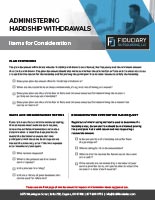
The Story
Lobsters-R-Delicious, Inc.’s 401(k) plan has never contained hardship withdrawal provisions. During a move to a new investment platform, a plan provision summary was provided to Janice, the HR person, that she was supposed to review. Janice missed that hardship withdrawals were indicated as being available on the plan provision summary which was then used to set up on-line withdrawals at the recordkeeper.
Several months ago a participant accessed his account on-line and requested a hardship withdrawal. Once Janice received notification that the withdrawal was approved by the recordkeeper, she contacted them to notify them that the Lobsters-R-Delicious plan does not allow for hardship withdrawals. The recordkeeper pointed to the plan provision form completed during the conversion and stated they had followed the provisions of that form. At this point, the plan had a problem as its operation failed to follow the plan document.
How did they fix it?
There were two possible remedies to this problem:
- Amend the plan retroactively to the date the participant took the hardship withdrawal to allow for hardship withdrawals for all.
- Explain to Timothy that he received money in error and ask for it back. If Timothy didn’t return the money, Lobsters-R-Delicious would need to ensure the plan was made whole.
Janice discussed the issue with the other plan fiduciaries and decided to allow hardship withdrawals in the future. The proper plan amendment was done. Since, in this case, the amendment occurred in the same year as the first hardship withdrawal, the only cost of correction was the cost of the plan amendment.
How did they avoid doing it again?
Janice realized that she didn’t have the necessary expertise to ensure seemingly minor errors like this weren’t made. After discussing her fiduciary obligations under ERISA with the company’s corporate counsel, Janet recommend to the CEO that they retain a fiduciary Plan Administrator to administer the plan in the future. After reviewing the available choices to fill such a position, Janet determined the Fiduciary Outsourcing offered all of the services she was looking for and ultimately hired us.

The Mistake
Many plans allow participants to withdraw funds from the plan in the event the participant incurs a financial hardship. In order to qualify for a hardship withdrawal, the participant must demonstrate their financial need (the “needs test”) and demonstrate that they can’t obtain the funds to meet their financial need from another source (the “means test”).
There are two ways to demonstrate that a hardship meets the needs test. The first way is to limit hardship withdrawals to the 6 reasons allowed by the IRS. The second way is to have the plan’s administrative fiduciary make a decision based on the facts and circumstances of the participant’s situation.
There are two ways to meet the means test. In the first, the participant must take a plan loan if it is available prior to taking the withdrawal and suspend making 401(k) contributions for a period of at least 6 months. In the second, the participant must provide sufficient proof for the plan’s administrative fiduciary to determine that there are no other funds available such as participant loans, commercial loans, loans from a life insurance policy, bank account balances, etc.
As you can probably tell, satisfying the first of the two in each case, the safe harbor method, is easier for the plan’s administrative fiduciary since no discretion is needed. However, if you use the other options, you are in a facts and circumstances situation. It is critical that you document each decision and be consistent in your decision making.
The next hurdle is that the participant cannot ask for more than they need, plus an appropriate amount to cover the estimated taxes on the distribution. You must have documentation in your records, or of your service provider team must have such documentation, in order to demonstrate that the amount distributed to the participant was appropriate. The participant is not supposed to check a box on a website page that basically says “I certify that this is what I need” and that’s all. There should be some proof somewhere. The burden to obtain the proof will rest with you, the plan administrative fiduciary, unless you have outsourced it to someone else.
If you elect the safe harbor needs test, the participant must first take a loan if one is available from the plan. If that isn’t sufficient to meet the hardship, the participant can take the hardship withdrawal. However, you must suspend their 401(k) deferrals for a period of at least 6, and possibly as many as 12, months. Check your plan document or ask your service provider team. And don’t forget, at the end of the suspension period, you may have to restart the deferrals. You’ll need to monitor these suspension periods so you know when the participant can begin saving again.

What Happens
There is more than one mistake that can be made here.
You can:
- Issue a hardship withdrawal when it wasn’t allowed.
- Act in an inconsistent manner when approving hardship withdrawals.
- Fail to obtain proof of the amount needed for the hardship.
- Fail to suspend the 401(k) deferrals.
- Fail to allow someone to defer again after the suspension period.
Let’s tackle each of these one at a time.
If you issue a hardship that wasn’t allowed, you need to return the plan to the position it was in before the error. So, you have to get the money back into the plan. You can try to get it from the participant or the Plan Sponsor can contribute it.
Let’s assume that you wouldn’t knowingly act in an inconsistent manner. That means someone else, like a DOL agent or a court, deems that you did. You are going to correct the error however the agent or the judge tells you to in the settlement.
If you fail to obtain proof when the hardship was issued, get it now. Put it in your files. Hopefully there is actual proof. If you discover that there wasn’t a hardship because there is no proof, you are going to have to put the money back in the plan by getting it from the participant or contributing it from the Plan Sponsor.
If you fail to suspend deferrals, start up the suspension right away. Document that you discovered the error and why it was missed in the first place. You may want to submit this to IRS under its correction program if you failed to suspend deferrals for a large number of participants or over a large period of time.
If you fail to allow someone to restart deferrals, they are treated as having a missed opportunity to defer. See our article on failures to allow someone to defer for the various corrections available.
Avoid it
The first step to ensuring hardship withdrawals are administered properly is to understand what your service provider team does for you with regard to hardship withdrawals.
- Will one of your service providers review hardship withdrawal applications to determine if they meet the criteria for a hardship?
- Who will obtain the necessary documentation for the hardship?
- Are any of your service providers responsible for confirming the amount available to the participant?
- Who will determine if the participant has other means of obtaining a hardship, such as a participant loan?
- Will your payroll provider and recordkeeper communicate to suspend deferrals and reinstatement?
With luck, your service provider team will be able to assist you with one or more of the items above. However, the work that they are unable to do will fall back on someone in your office.
A best practice would be to designate a person and their backup to be the responsible parties. Ensure these staff have read the appropriate sections of the plan document. Provide training to these staff, that may be available through your service provider team, to understand the rules. Create a written process that is followed every time there is a hardship withdrawal. Take steps to ensure that the written procedures created are followed each and every time there is a hardship withdrawal request.

How We Help
You have the ability to outsource your responsibilities as the Plan Administrator. As such, you can outsource the responsibility to oversee hardship withdrawal requests. You can also outsource the responsibility to start and stop 401(k) deferral suspensions to us. You can even outsource reviewing plan provision setup when you move service providers to us. The more you outsource, the less liability you would have with regard to hardship withdrawals being administered properly.

Checklist

The Story
Lobsters-R-Delicious, Inc.’s 401(k) plan has never contained hardship withdrawal provisions. During a move to a new investment platform, a plan provision summary was provided to Janice, the HR person, that she was supposed to review. Janice missed that hardship withdrawals were indicated as being available on the plan provision summary which was then used to set up on-line withdrawals at the recordkeeper.
Several months ago a participant accessed his account on-line and requested a hardship withdrawal. Once Janice received notification that the withdrawal was approved by the recordkeeper, she contacted them to notify them that the Lobsters-R-Delicious plan does not allow for hardship withdrawals. The recordkeeper pointed to the plan provision form completed during the conversion and stated they had followed the provisions of that form. At this point, the plan had a problem as its operation failed to follow the plan document.
How did they fix it?
There were two possible remedies to this problem:
- Amend the plan retroactively to the date the participant took the hardship withdrawal to allow for hardship withdrawals for all.
- Explain to Timothy that he received money in error and ask for it back. If Timothy didn’t return the money, Lobsters-R-Delicious would need to ensure the plan was made whole.
Janice discussed the issue with the other plan fiduciaries and decided to allow hardship withdrawals in the future. The proper plan amendment was done. Since, in this case, the amendment occurred in the same year as the first hardship withdrawal, the only cost of correction was the cost of the plan amendment.
How did they avoid doing it again?
Janice realized that she didn’t have the necessary expertise to ensure seemingly minor errors like this weren’t made. After discussing her fiduciary obligations under ERISA with the company’s corporate counsel, Janet recommend to the CEO that they retain a fiduciary Plan Administrator to administer the plan in the future. After reviewing the available choices to fill such a position, Janet determined the Fiduciary Outsourcing offered all of the services she was looking for and ultimately hired us.

The Mistake
Many plans allow participants to withdraw funds from the plan in the event the participant incurs a financial hardship. In order to qualify for a hardship withdrawal, the participant must demonstrate their financial need (the “needs test”) and demonstrate that they can’t obtain the funds to meet their financial need from another source (the “means test”).
There are two ways to demonstrate that a hardship meets the needs test. The first way is to limit hardship withdrawals to the 6 reasons allowed by the IRS. The second way is to have the plan’s administrative fiduciary make a decision based on the facts and circumstances of the participant’s situation.
There are two ways to meet the means test. In the first, the participant must take a plan loan if it is available prior to taking the withdrawal and suspend making 401(k) contributions for a period of at least 6 months. In the second, the participant must provide sufficient proof for the plan’s administrative fiduciary to determine that there are no other funds available such as participant loans, commercial loans, loans from a life insurance policy, bank account balances, etc.
As you can probably tell, satisfying the first of the two in each case, the safe harbor method, is easier for the plan’s administrative fiduciary since no discretion is needed. However, if you use the other options, you are in a facts and circumstances situation. It is critical that you document each decision and be consistent in your decision making.
The next hurdle is that the participant cannot ask for more than they need, plus an appropriate amount to cover the estimated taxes on the distribution. You must have documentation in your records, or of your service provider team must have such documentation, in order to demonstrate that the amount distributed to the participant was appropriate. The participant is not supposed to check a box on a website page that basically says “I certify that this is what I need” and that’s all. There should be some proof somewhere. The burden to obtain the proof will rest with you, the plan administrative fiduciary, unless you have outsourced it to someone else.
If you elect the safe harbor needs test, the participant must first take a loan if one is available from the plan. If that isn’t sufficient to meet the hardship, the participant can take the hardship withdrawal. However, you must suspend their 401(k) deferrals for a period of at least 6, and possibly as many as 12, months. Check your plan document or ask your service provider team. And don’t forget, at the end of the suspension period, you may have to restart the deferrals. You’ll need to monitor these suspension periods so you know when the participant can begin saving again.

What Happens
There is more than one mistake that can be made here.
You can:
- Issue a hardship withdrawal when it wasn’t allowed.
- Act in an inconsistent manner when approving hardship withdrawals.
- Fail to obtain proof of the amount needed for the hardship.
- Fail to suspend the 401(k) deferrals.
- Fail to allow someone to defer again after the suspension period.
Let’s tackle each of these one at a time.
If you issue a hardship that wasn’t allowed, you need to return the plan to the position it was in before the error. So, you have to get the money back into the plan. You can try to get it from the participant or the Plan Sponsor can contribute it.
Let’s assume that you wouldn’t knowingly act in an inconsistent manner. That means someone else, like a DOL agent or a court, deems that you did. You are going to correct the error however the agent or the judge tells you to in the settlement.
If you fail to obtain proof when the hardship was issued, get it now. Put it in your files. Hopefully there is actual proof. If you discover that there wasn’t a hardship because there is no proof, you are going to have to put the money back in the plan by getting it from the participant or contributing it from the Plan Sponsor.
If you fail to suspend deferrals, start up the suspension right away. Document that you discovered the error and why it was missed in the first place. You may want to submit this to IRS under its correction program if you failed to suspend deferrals for a large number of participants or over a large period of time.
If you fail to allow someone to restart deferrals, they are treated as having a missed opportunity to defer. See our article on failures to allow someone to defer for the various corrections available.
Avoid it
The first step to ensuring hardship withdrawals are administered properly is to understand what your service provider team does for you with regard to hardship withdrawals.
- Will one of your service providers review hardship withdrawal applications to determine if they meet the criteria for a hardship?
- Who will obtain the necessary documentation for the hardship?
- Are any of your service providers responsible for confirming the amount available to the participant?
- Who will determine if the participant has other means of obtaining a hardship, such as a participant loan?
- Will your payroll provider and recordkeeper communicate to suspend deferrals and reinstatement?
With luck, your service provider team will be able to assist you with one or more of the items above. However, the work that they are unable to do will fall back on someone in your office.
A best practice would be to designate a person and their backup to be the responsible parties. Ensure these staff have read the appropriate sections of the plan document. Provide training to these staff, that may be available through your service provider team, to understand the rules. Create a written process that is followed every time there is a hardship withdrawal. Take steps to ensure that the written procedures created are followed each and every time there is a hardship withdrawal request.

How We Help
You have the ability to outsource your responsibilities as the Plan Administrator. As such, you can outsource the responsibility to oversee hardship withdrawal requests. You can also outsource the responsibility to start and stop 401(k) deferral suspensions to us. You can even outsource reviewing plan provision setup when you move service providers to us. The more you outsource, the less liability you would have with regard to hardship withdrawals being administered properly.

Checklist

